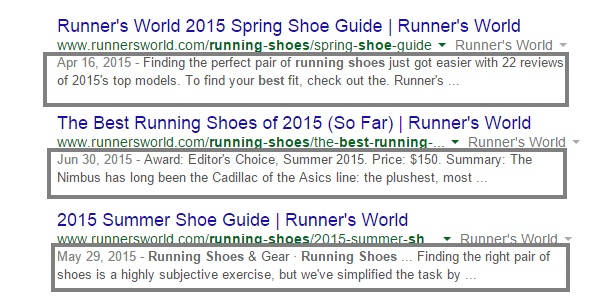The Basics of Meta Page Descriptions
Google may not factor in a page’s meta description when determining how a page ranks, but that doesn’t mean it should be an afterthought. Pay as much attention to crafting an effective meta page description as you paid to crafting the copy on the page itself. Let’s look at why.
What is a meta page description?
A meta page description is an advertisement for your page. It’s the snippet of text that appears with the search results. Here’s a SERP that appears for the keywords “best running shoes.” The meta page descriptions are in the gray boxes.

What is the purpose of a meta page description?
These snippets of text have two main goals:
- To entice searchers to click the link to the page
- To let searchers know what’s on the page
Meta page descriptions are one of your final chances to convince web searchers to click your page, not the other pages that appear on the SERP.
How do you write a meta page description?
When writing a meta page description, think about enticing the web searcher with your copy while also letting the searcher know what’s on the page. After all, what’s more annoying than going to a web page and not seeing what you expected to find?
Keep these things in mind when writing a meta page description:
- Keep it between 120 and 160 characters. Too short and you don’t accomplish your goals and it looks flimsy on the search results page. Too long and Google cuts the end off.
- Use the keyword for the page in the meta description.
- Strike a nice balance between letting the searcher know what they’ll find on the page and enticing them to click.
It’s easy to write off a meta page description as unimportant when you’re careful to place effective keywords on your page, craft an effective title page and do all the other stuff that Google does factor in for SEO purposes. But don’t. Meta page descriptions are just as important.
If you enjoyed this post, read more by Stacy!
Stacy Dyer—Content Strategist



